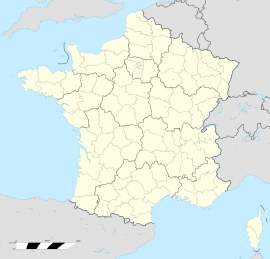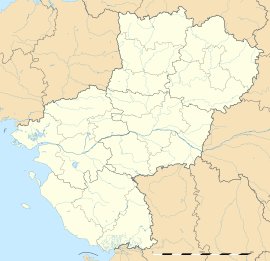Laigné facts for kids
Quick facts for kids
Laigné
|
|
|---|---|
|
Part of Prée-d'Anjou
|
|
| Country | France |
| Region | Pays de la Loire |
| Department | Mayenne |
| Arrondissement | Château-Gontier |
| Canton | Château-Gontier |
| Commune | Prée-d'Anjou |
| Area
1
|
21.54 km2 (8.32 sq mi) |
| Population
(2019)
|
834 |
| • Density | 38.72/km2 (100.28/sq mi) |
| Time zone | UTC+01:00 (CET) |
| • Summer (DST) | UTC+02:00 (CEST) |
| Postal code |
53200
|
| Elevation | 45–94 m (148–308 ft) (avg. 68 m or 223 ft) |
| 1 French Land Register data, which excludes lakes, ponds, glaciers > 1 km2 (0.386 sq mi or 247 acres) and river estuaries. | |
Laigné (pronounced roughly "Len-yay") was a small town, also known as a commune, located in the Mayenne department in north-western France. It was once an independent area with its own local government.
On January 1, 2018, Laigné joined with another commune to form a new, larger commune called Prée-d'Anjou. This means Laigné is no longer a separate commune on its own.
Contents
Where Was Laigné Located?
Laigné was found in the western part of France. It was part of the Mayenne department, which is like a county or region. This area is known for its green landscapes and quiet countryside.
Geographical Features of Laigné
The land where Laigné was located had different elevations. The lowest point was about 45 meters (148 feet) above sea level. The highest point reached about 94 meters (308 feet). The average elevation was around 68 meters (223 feet).
The total area of Laigné was about 21.54 square kilometers (8.32 square miles). This is roughly the size of a medium-sized park or a few thousand football fields.
Population of Laigné
Before it merged, Laigné was home to a small community. In 2019, the population was recorded as 834 people. This shows it was a relatively small place, often found in rural parts of France.
What is a Commune?
In France, a commune is the smallest unit of local government. It's like a town or a village with its own mayor and local council. Communes handle many local services, such as schools, roads, and public safety. When communes merge, they combine their resources and administration to form a larger, new commune. This can happen to make local government more efficient.
See also
 In Spanish: Laigné para niños
In Spanish: Laigné para niños



